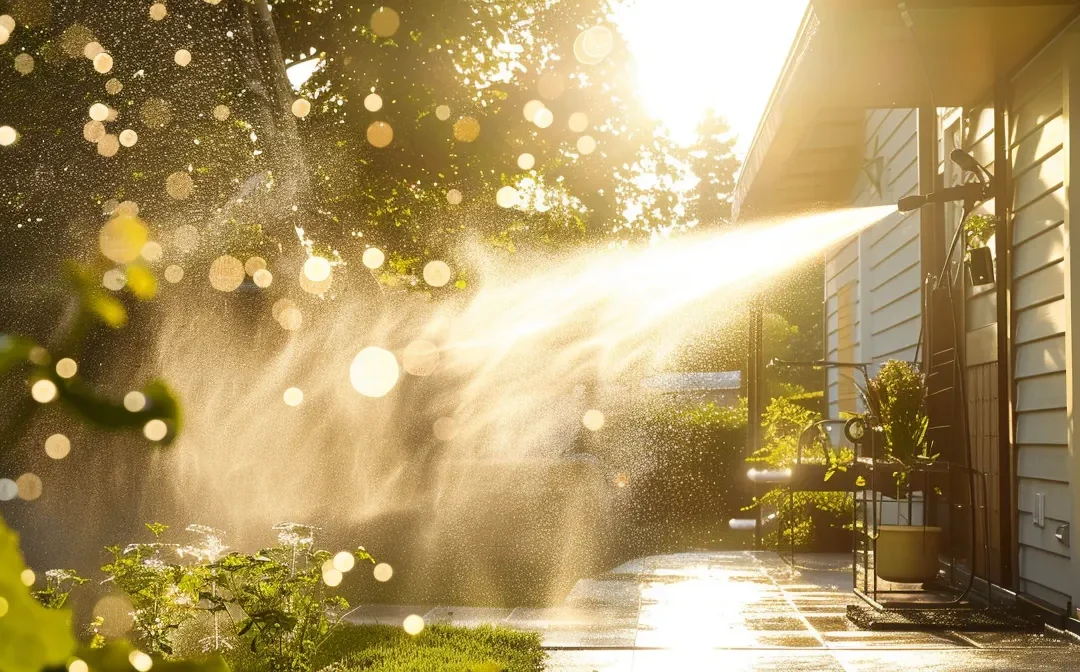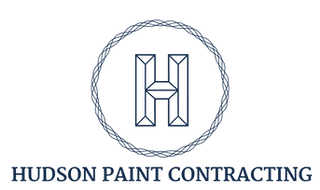Power Washing vs Pressure Washing: What’s the Difference?
When it comes to maintaining the cleanliness of outdoor surfaces, many people confuse power washing with pressure washing. Understanding the difference between these two cleaning methods can be crucial for homeowners facing stubborn soil, oil, or mortar stains. This article will clarify the definitions of power washing and pressure washing, highlight key differences, and explore the best techniques for various exteriors. By engaging with this content, readers will gain valuable insights that can help them choose the right cleaner for their needs and ensure that their surfaces remain in warranty condition.
Key Differences Between Power and Pressure Washing
- Power washing uses heated water, making it effective for mildew and deep stains
- Pressure washing employs cold water for routine cleaning and maintenance tasks
- Understanding the methods aids consumers in choosing the right cleaning approach for specific surfaces
- Safety gear and proper techniques are crucial to avoid damage during cleaning processes
- Professional services offer expertise that ensures effective cleaning and maintenance of property aesthetics
Understanding the Definition of Power Washing and Pressure Washing
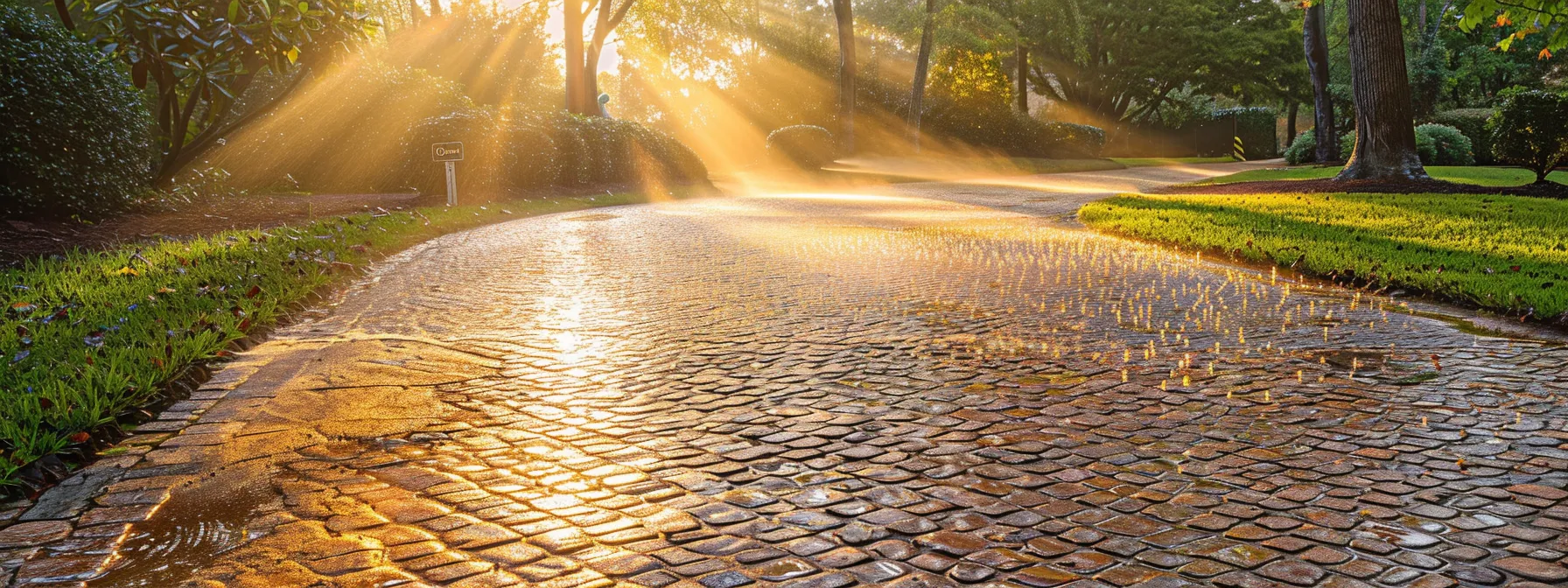
Power washing uses heated water for cleaning surfaces, making it effective for removing mildew and deep stains, particularly on roofs and driveways. In contrast, pressure washing delivers a strong jet of cold water and is suitable for high-impact tasks like cleaning walkways and siding. Understanding these definitions and applications helps consumers choose the right method for their specific needs.
Power Washing Defined and Its Applications
power washing services utilize heated water to effectively clean various surfaces, making it an ideal solution for maintaining patios and wooden decks. This method excels at removing stubborn dirt, mildew, and deep stains, ensuring that surfaces not only look revitalized but are also safe for use. Customers seeking to enhance their outdoor spaces will find that power washing not only improves aesthetics but also exemplifies the commitment to quality customer service in maintaining property value.
Pressure Washing Defined and Its Applications
Pressure washing is a technique that employs a strong jet of cold water to remove dirt, dust, and grime from various surfaces. This method is particularly effective in preparing areas for the application of sealants, ensuring that pathways, driveways, and siding are cleaned thoroughly before any protective measures are taken. With changing climate conditions, regular pressure washing becomes essential for maintaining property aesthetics and preventing deterioration caused by accumulated dirt and organic material.
| Method | Temperature | Applications | Benefits |
|---|---|---|---|
| Pressure Washing | Cold Water | Siding, Walkways, Driveways | Effective dirt and dust removal, Prepares surfaces for sealants |
| Power Washing | Heated Water | Patios, Wooden Decks, Roofs | Removes mildew and deep stains, Enhances safety and aesthetics |
Power washing and pressure washing share similarities, yet their differences shape the result. In the next section, the distinct characteristics of each method will unfold, revealing which is best for your needs.
Analyzing the Key Differences Between Power Washing and Pressure Washing
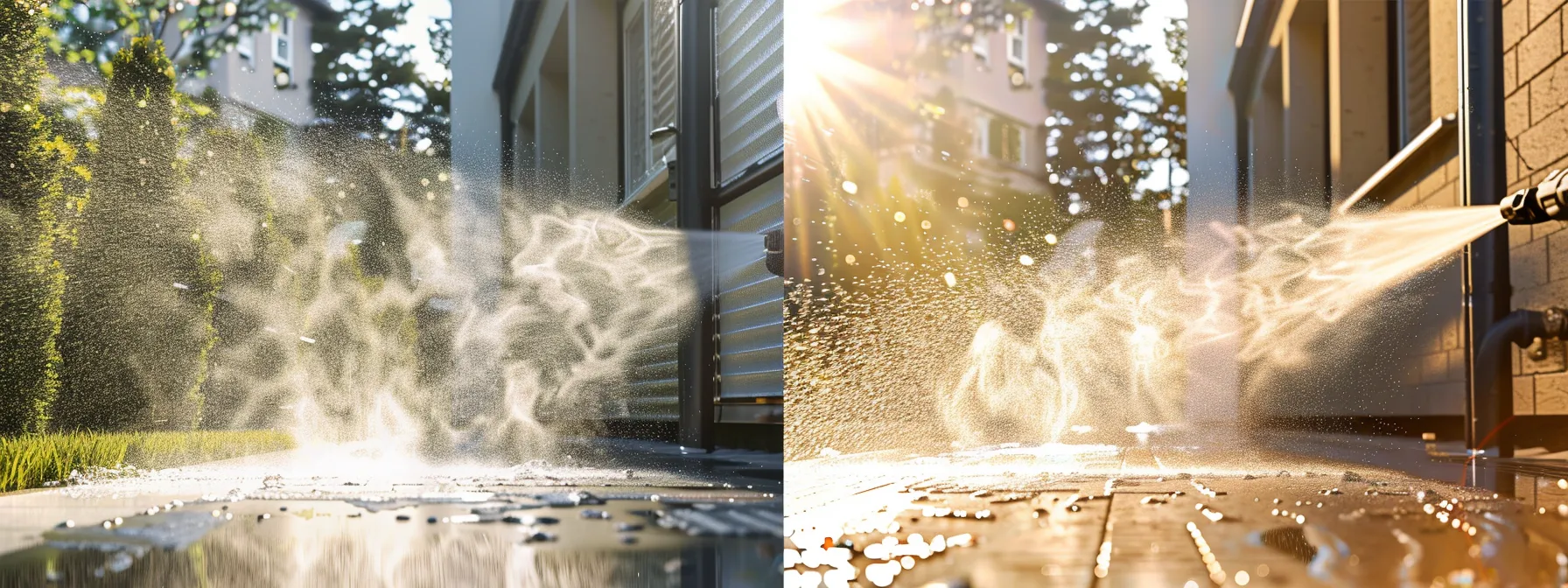
Comparing the water pressure levels in both power washing and pressure washing reveals crucial differences that impact cleaning efficiency. Evaluating the types of soap used in each method helps determine their effectiveness against grime and mildew. Assessing the cleaning techniques and equipment used will provide clarity on their respective applications. This examination also guides when to choose power washing or pressure washing for specific tasks, such as maintaining vinyl siding or refinishing services.
Comparing Water Pressure Levels in Both Methods
When comparing water pressure levels in power washing and pressure washing, understanding the implications for cleaning effectiveness is essential. Power washing utilizes higher pressure levels, which can efficiently remove stubborn moss and mildew, reducing the risk of hazards that could compromise safety. Conversely, pressure washing employs lower pressure, making it ideal for less intense cleaning tasks that still enhance curb appeal and prepare surfaces for further treatments. Seeking a free quote from a professional service can help determine the most suitable method for specific needs while ensuring the property remains safe and visually appealing.
Evaluating the Type of Cleaning Solutions Used
When evaluating the type of cleaning solutions used in power washing and pressure washing, it is essential to consider their environmental impact and effectiveness against specific contaminants. Power washing often employs detergents that are environmentally friendly and specifically formulated to tackle deep-seated stains, algae, and mildew. In contrast, pressure washing may utilize stronger acids in its cleaning solutions to break down tough grime, making it particularly effective for surfaces like driveways that require intense cleaning. Understanding the right choice of cleaning solutions guides consumers toward the method that best fits their needs while being conscious of the environment:
- Power washing uses environmentally friendly detergents.
- Pressure washing can involve stronger acids for tougher cleaning tasks.
- Both methods can effectively target algae and other contaminants.
- Choosing the right solution can enhance cleaning efficiency and safety.
- Professional services may utilize ladders for hard-to-reach areas when applying these solutions.
Assessing the Cleaning Techniques and Equipment
Assessing the cleaning techniques and equipment used in power washing and pressure washing highlights significant variances in their effectiveness on various surfaces such as stucco and pavers. Power washing often involves specialized gear that combines heated water with specific spray nozzle techniques to tackle deep stains and moss. On the other hand, pressure washing utilizes standard equipment and high-pressure spray to effectively clean areas while ensuring customer satisfaction with improved aesthetics.
| Method | Key Features | Ideal Surfaces | Common Equipment |
|---|---|---|---|
| Power Washing | Heated water, specialized nozzles | Stucco, wooden decks | Commercial power washer, adjustable spray nozzles |
| Pressure Washing | High-pressure cold water | Pavers, driveways | Electric pressure washer, standard spray wands |
When to Choose Power Washing vs Pressure Washing
Choosing between power washing and pressure washing often hinges on the type of cleaning required. For instance, if a surface is heavily stained with mildew or has accumulated dirt over time, power washing with its heated water and specialized nozzle can effectively restore it, particularly for decks and roofs. Conversely, for routine maintenance tasks like clearing leaves and general grime from driveways or walkways, pressure washing suffices and enhances curb appeal without risking damage to the surface.
| Method | Best Use Cases | Recommended Surfaces |
|---|---|---|
| Power Washing | Removing deep stains and mildew | Decks, roofs, patios |
| Pressure Washing | Routine cleaning and maintenance | Driveways, walkways, siding |
Understanding the differences in washing methods sets the stage for effective results. It is time to explore the best techniques suited for various exteriors, ensuring the job is done right.
Identifying the Best Power Washing Techniques for Different Exteriors

Effective power washing techniques vary based on the type of exterior being cleaned. For concrete surfaces, methods focus on removing mold and debris efficiently. Wooden decks and fences require maintenance approaches that preserve their integrity while eliminating contaminants. Glass and windows benefit from specialized practices that ensure clarity, while vinyl siding cleaning adopts effective strategies for thorough dirt removal. Each of these topics offers valuable insights into maintaining property aesthetics and longevity.
Techniques for Cleaning Concrete Surfaces Effectively
When cleaning concrete surfaces like driveways and sidewalks, professionals recommend using a combination of power washing techniques to achieve optimal results. Utilizing hot water can effectively eliminate tough stains and organic growth commonly found in masonry, ensuring that the surface appears renewed and well-maintained. This approach not only enhances the aesthetic appeal of the landscape but also contributes to long-term durability, making it an essential practice for homeowners looking to preserve their property’s value, particularly when combined with services such as kitchen cabinet refinishing for an overall refreshed look.
Methods for Maintaining Wooden Decks and Fences
Maintaining wooden decks and fences requires careful attention to moisture levels and protective measures against pollen and water damage. Professionals recommend using a mixture of vinegar and water to naturally clean surfaces, which helps eliminate dirt and potential mildew without harsh chemicals. Additionally, employing a soft-bristle brush during the cleaning process can effectively remove debris without compromising the integrity of the wood, ensuring long-lasting beauty and durability:
| Method | Purpose | Tools Required |
|---|---|---|
| Vinegar Solution | Natural cleaning and mildew prevention | Mixing bucket, spray bottle |
| Soft-Bristle Brush | Gentle scrubbing to protect wood | Brush with soft bristles |
| Frequent Inspection | Identify water damage early | Visual checks for moisture damage |
Best Practices for Washing Glass and Windows
Washing glass and windows requires careful attention to avoid streaks and damage. Using a gentle approach with a soft cloth or squeegee is essential for achieving a clear finish, while a mixture of water and a mild detergent effectively removes dirt and grime. For those with fences near windows, ensuring that spray doesn’t damage the surrounding wood is crucial, highlighting the importance of using lower pressure settings during the cleaning process to maintain both clarity and the integrity of adjacent surfaces.
Effective Approaches for Vinyl Siding Cleaning
For effective vinyl siding cleaning, professionals recommend using a low-pressure wash combined with specialized soft cleaning solutions to avoid damage to the siding. This method ensures that grime, dirt, and mildew are thoroughly removed while protecting the integrity of the material. Regular maintenance of vinyl siding, through power washing or pressure washing, enhances the home’s curb appeal and prolongs the lifespan of the exterior finish.
Each technique has its own strengths, shaping how surfaces are cleaned. Next, we’ll look at the unique advantages these methods offer.
Exploring the Benefits of Each Cleaning Method
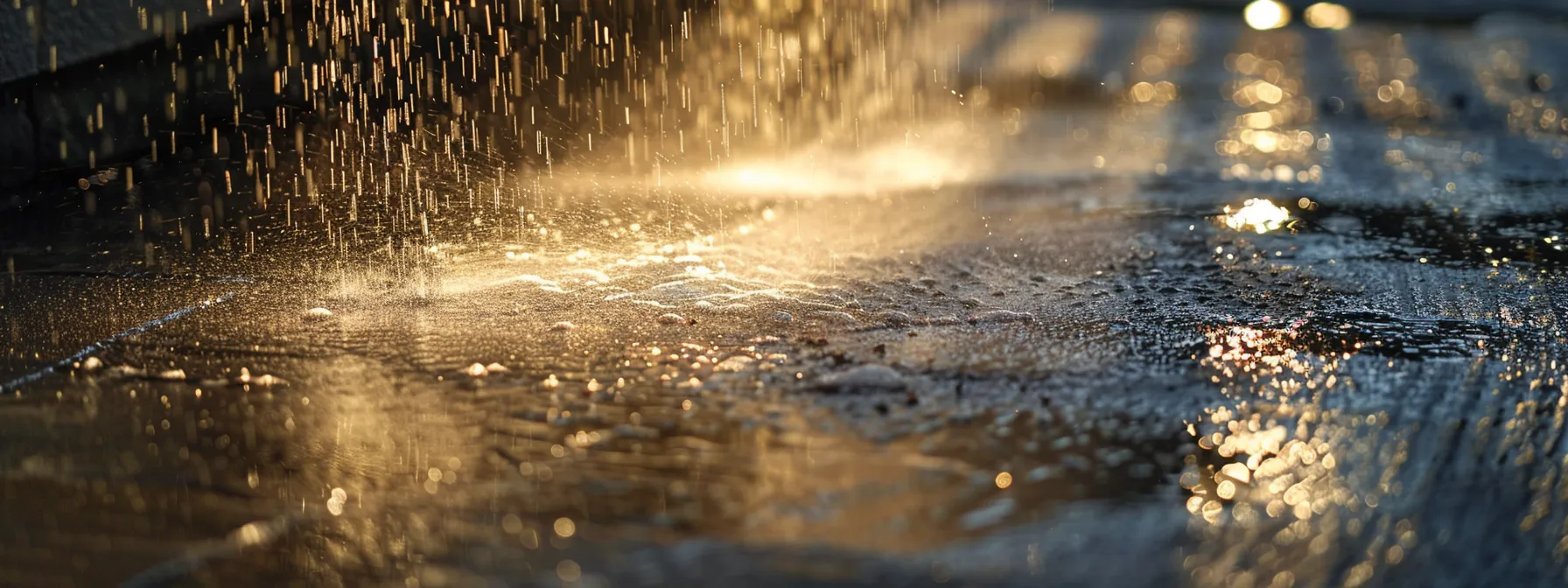
Power washing offers significant advantages for tackling tough stains, effectively removing stubborn dirt and mildew from various surfaces. In contrast, pressure washing excels in surface maintenance, ensuring that areas like driveways and walkways remain clean and appealing. Understanding these benefits and their long-term impacts on exterior surfaces aids property owners in making informed decisions regarding their cleaning needs.
Advantages of Power Washing for Tough Stains
Power washing provides a powerful solution for tackling tough stains on various surfaces. Utilizing heated water, this method effectively dissolves deep-seated dirt, mildew, and stubborn grime, making it ideal for surfaces like patios and roofs. For homeowners dealing with significantly stained areas, power washing not only restores the visual appeal of their properties but also helps to maintain the safety and integrity of these exterior surfaces.
Benefits of Pressure Washing for Surface Maintenance
Pressure washing plays a vital role in maintaining the appearance and longevity of surfaces such as driveways, sidewalks, and siding. By effectively removing dirt, dust, and grime, this method not only enhances curb appeal but also prevents degradation caused by accumulated contaminants. Property owners benefit from regular pressure washing, as it creates a clean and safe environment, ultimately increasing the value and aesthetic appeal of their properties.
Long-Term Impacts on Exterior Surfaces
The long-term impacts of power washing and pressure washing on exterior surfaces significantly influence property maintenance and longevity. Regularly utilizing power washing can prevent the buildup of mildew, algae, and other stains that may lead to deterioration over time, particularly on decks and roofs. On the other hand, pressure washing plays a crucial role in preserving the appearance of driveways and walkways by eliminating dirt and grime, ultimately enhancing the property’s curb appeal and value.
Each cleaning method has its strengths. Yet, the true measure of safety lies in understanding the precautions that protect both the worker and the surface.
Understanding Safety Protocols and Precautions

Safety gear recommendations for power washing and pressure washing are crucial to protect operators and bystanders. Understanding the risks associated with improper washing techniques, such as surface damage or injury, emphasizes the importance of adhering to essential practices during cleaning. This section will cover necessary precautions to ensure effective and safe cleaning processes while preserving the integrity of various surfaces.
Safety Gear Recommendations for Both Methods
Using appropriate safety gear is essential for both power washing and pressure washing to ensure operator protection and prevent injury. Operators should wear safety goggles to shield their eyes from debris and spray, heavy-duty gloves to protect their hands from chemicals and sharp edges, and non-slip footwear to maintain stability on wet surfaces. Additionally, employing ear protection can minimize noise exposure from the equipment, allowing for a safer and more efficient cleaning process while safeguarding various surfaces from potential damage.
Risks Associated With Improper Washing Techniques
Improper washing techniques can lead to significant risks, including surface damage and personal injury. For instance, using excessive pressure on delicate materials like siding or wood can result in dents, cracks, or even surface erosion, compromising both appearance and durability. Additionally, without proper safety measures, operators may face hazards such as slips and falls, or chemical exposure from cleaning solutions, underscoring the importance of adhering to safety protocols when engaging in power washing or pressure washing activities.
Essential Practices to Avoid Damage During Cleaning
To avoid damage during power washing or pressure washing, operators should take essential precautions tailored to the specific surfaces being cleaned. For instance, testing pressure settings and using appropriate nozzles can prevent harm to delicate materials, ensuring effective cleaning without compromising surface integrity. Additionally, maintaining a safe distance from the surface while applying pressure helps to eliminate the risk of chipping or stripping paint, allowing for a safe and efficient cleaning process:
| Practice | Purpose | Tips |
|---|---|---|
| Test Pressure Settings | Prevent surface damage | Start with a lower setting and adjust as needed |
| Use Appropriate Nozzles | Ensure effective cleaning | Select nozzles based on surface type |
| Maintain Safe Distance | Avoid chipping or stripping | Keep a consistent distance from the surface |
Safety is vital, but understanding costs is equally important. Evaluating the economic factors will reveal the true value of your investment.
Evaluating Cost Comparisons and Economic Factors

Analyzing cost differences between power washing and pressure washing reveals important factors that influence pricing for professional services. The following sections will explore the economic implications of choosing DIY approaches versus hiring professionals, providing a cost-benefit analysis. Understanding these financial considerations equips property owners with the necessary insights to make informed decisions regarding their cleaning needs.
Analyzing the Cost Differences Between the Two Methods
When analyzing the cost differences between power washing and pressure washing, several factors come into play that can impact overall expenses. Power washing typically incurs higher service costs due to the need for specialized equipment and heated water, making it more effective for heavy-duty cleaning tasks. In contrast, pressure washing services often come at a lower price point, as the equipment used is less complex and suitable for routine maintenance jobs. Understanding these financial distinctions allows property owners to make informed choices based on their specific cleaning needs and budget constraints.
Factors That Influence Pricing for Professional Services
Several factors influence pricing for professional power washing and pressure washing services. These include the size and condition of the area to be cleaned, the difficulty of access, and the specific equipment required for the job. Additionally, the choice between using heated water for power washing or cold water for pressure washing can significantly affect costs, as higher service fees are often associated with the more specialized equipment and techniques employed in power washing, thereby providing clients with effective solutions tailored to their cleaning needs.
DIY vs Professional Services: Cost-Benefit Analysis
When considering power washing or pressure washing, property owners often weigh the benefits of DIY approaches against hiring professional services. While a DIY method may initially seem more cost-effective, the potential for mistakes and equipment rental costs can quickly add up. On the other hand, professional services not only provide expertise but also save time and ensure thorough cleaning, making them a valuable investment for maintaining property aesthetics and safety:
- DIY methods can incur hidden costs like equipment rental and cleaning solutions.
- Professionals offer expertise that minimizes the risk of damage to surfaces.
- Time savings from hiring professionals can often outweigh saving money through DIY efforts.
- Long-term benefits include maintained property value and enhanced curb appeal.
Conclusion
Understanding the differences between power washing and pressure washing is crucial for property owners aiming to maintain their exteriors effectively. Each method serves distinct purposes, with power washing excelling at removing tough stains and mildew, while pressure washing is ideal for routine maintenance. Making informed choices about these techniques can enhance property value and aesthetic appeal. By recognizing when to utilize each method, homeowners can ensure their outdoor spaces remain clean, safe, and inviting.
